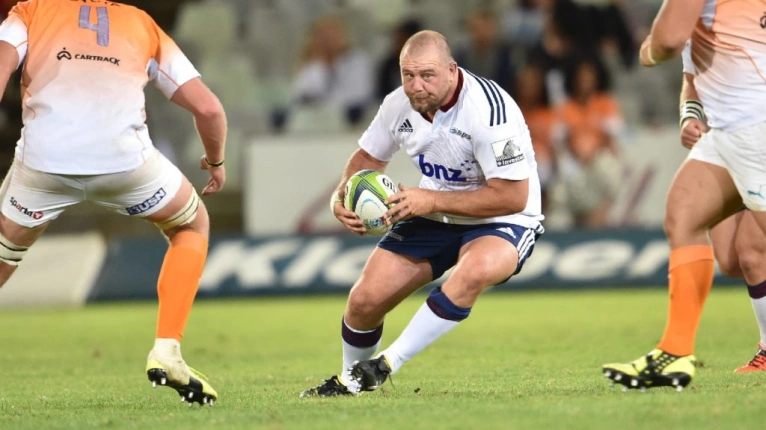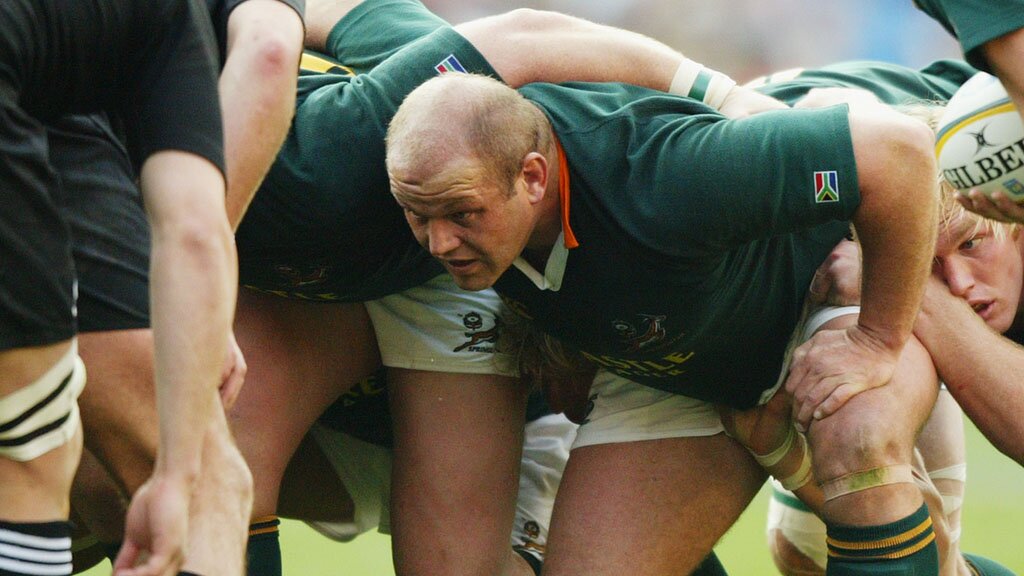Loosehead Prop Position Guide

Although the props rarely make the headlines, the game of rugby would not be able to function without these powerful workhorses.
Some people think they’re just battering rams, the role of the prop is more nuanced than it used to be. For this reason, legendary commentator Bill McLaren has referred to the props as being as “cunning as a bag o’ weasels”.
In this guide, we’ll take an in-depth look at the role a loosehead prop plays during a rugby union match.
We’ll cover the basics of the position, what a loosehead prop does, the physical attributes of a loosehead prop and some of the most famous players to ever play the position.
We’ll even conclude by providing you with some loosehead prop tips.
What is a loosehead prop?
The loosehead prop is a member of the team’s front row (alongside the hooker and the tighthead prop). They’re one of the three players in the front row of the scrum.
The loosehead prop lines up on the left of the scrum, next to the hooker. During the scrum, they push against the opposing tighthead prop and aim to overpower them.
The loosehead prop position gets its name because the player’s head is on the outside of the scrum when it engages. While the tighthead prop’s head is surrounded by the opposition, the head of the loosehead prop remains loose throughout the scrum.
Other names for a loosehead prop
Some rugby positions are known by different names in different parts of the world. For example, the number eight is known as the eighthman in South Africa, while the fly-half is known as the first five-eighth in New Zealand.
However, the loosehead prop is known by the same name around the world.
What number is a loosehead prop?
In a game of rugby union, starting players wear numbers 1-15.
The loosehead prop always wears number 1. Their tighthead counterpart wears 3, and the hooker that stands between them in the front row of the scrum wears number 2.
What is the average size of a loosehead prop?
Due to the physical nature of their role, loosehead props tend to be among the biggest and strongest players on the field.
Typically, most loosehead props are around 6ft tall (1.83m). Plus, the normal weight range for a top-level loosehead prop is 110-120kg (242-264lbs). In this respect, the loosehead prop is usually slightly lighter than their tighthead counterpart. However, there are exceptions to this rule. For example, Karl Tu’inukuafe, who plays at loosehead prop for the All Blacks, weighs a whopping 135kg (297lbs).
On top of their size and weight, loosehead props are expected to be incredibly strong. At the international level, it’s not uncommon for a loosehead prop to bench press around 200kg and squat 300kg.
Of course, you don’t need to possess this level of strength and size in order to play rugby for your local club. But, these statistics show you the physical power that loosehead props possess and the work they constantly put in at the gym.
What is the loosehead prop’s role?
The role of the loosehead prop is very tough and physical. However, they do not quite deal with the same load as the tighthead in the scrum. Due to this, they’re expected to do additional work around the field.
Although the role of the loosehead prop used to be almost entirely confined to set pieces, the modern loosehead prop is expected to carry the ball more and hit plenty of rucks. They’re also expected to show good mobility around the field. Now, loosehead props are more dynamic than they once were, and they’re expected to have good ball-handling skills.
That said, the priority for a loosehead prop is still to push and be solid in the scrum. With this in mind, let’s take a look at their role at set pieces in greater detail.
What is the loosehead prop’s role in scrums?
While the tighthead prop is the cornerstone of a scrum, the loosehead prop is tasked with trying to get under their opposite tighthead prop and drive them upwards. Meanwhile, the tighthead prop will try to pin down the loosehead using their greater weight (essentially, each scrum has two battles of supremacy between looseheads and tightheads).
At the scrum, the loosehead prop is expected to bind as tightly as possible with the hooker. This way, they are as close as possible to the ball when it’s put into the scrum. In addition, by binding tightly with the hooker, they can ensure that they do not become split from each other. Plus, the loosehead prop should also reach as far forward as is comfortable with their outside arm when the scrum engages.
Once the ball enters the scrum, the role of the loosehead prop is to push upwards slightly. This way, they allow the hooker to have an easier strike at the ball. The loosehead must ensure that the hooker is not under pressure and can channel the ball by staying square.
During the scrum, the loosehead prop aims to dominate the opposition’s tighthead prop. This way, their weight will be transferred backwards.
Added to this, the loosehead prop should be in constant communication with their teammates. By analysing the scrum, they can improve their tactics and execution.
What is the loosehead prop’s role in lineouts?
At the lineout, the loosehead prop will support jumpers and aim to protect the ball. As well as helping teammates jump, they will also stabilise them at the maximum height. Once the ball has been secured, they will make sure the jumper lands in a stable body position with their back to the opposition.
Due to the pivotal role they play at the lineout, a loosehead prop must know all of the team’s lineout moves well, including the ones they’re not involved in. After all, they may still be required to hold the line and provide a protective screen when the ball is not thrown to the back.
Notable loosehead props

In the RugbyPass Hall of Fame vote, fans told us they thought that Os du Randt was the greatest loosehead prop of all-time. A giant of South African rugby, he was affectionately known as ‘The Ox’ due to his size and stature. Partly due to his power and skill at the scrum, the Springboks won two editions of the Rugby World Cup (1995 and 2007) with him at loosehead prop.
Tony Woodcock is another notable loosehead prop. Between 2002 and 2015, he was capped a whopping 118 times by New Zealand. Once described as having the ‘best range of skills of any prop on the planet’, he’s one of only a handful of players that have won multiple Rugby World Cups.
In the northern hemisphere, Jason Leonard is arguably the greatest loosehead prop to ever play the game. Formerly England’s most-capped player, he won four Six Nations Grand Slam titles and one edition of the Rugby World Cup.
Today, some of the world’s best rugby players occupy the loosehead prop position. The best loosehead props on the planet include Mako Vunipola (England), Scott Sio (Australia) and Joe Moody (New Zealand).
FAQs
Here at RugbyPass, we’re asked a number of questions about the role that a loosehead prop plays during a game. To help you learn more, here we’ve answered a number of popular reader questions.
What is the difference between loosehead and tighthead prop?
There is a massive difference between the role of the loosehead and the tighthead prop.
In the scrum, the loosehead prop gets a lot of weight on their back and neck from the opposition’s tighthead. Remember, while loosehead props are trying to stay upright, tighthead props are trying to bear down and stay strong.
As the positions vary and different muscles and different parts of the body are required, very few people have successfully played in both positions at an elite level. However, one player who did play in both positions to a world-class level was Jason Leonard, who was capped more than 100 times by England.
What training do loosehead props do?
Although loosehead props are an integral part of the team, they do a lot of training away from the main group. This is because their role is very specialised and they need to spend a great deal of time working on their scrummaging ability. They will also hold separate meetings purely to discuss set pieces.
In the week leading up to a game, loosehead props will do a lot of live scrummaging work. Generally, they will go head-to-head with two different packs, so they can work on their endurance and stamina. They will also run through drills and continually work through physical set pieces. Work like this is physically intense and requires a great deal of commitment.
In the last couple of days before a game, loosehead props will generally scale down their workloads and focus on the more technical aspects of the job. This way, they’re fresh for kickoff. In the gym, they will focus on bench pulls, back work and neck work.
What loosehead prop tips do you have?
Loosehead prop is a highly specialised position and the ‘dark arts’ of rugby are encouraged in the scrum. For instance, it can be advantageous if the loosehead prop can get their head underneath the opposing tighthead’s, and onto the opponent’s chest.
Similarly, if you’re under pressure in the scrum, placing your left foot forward will put you in a more stable position. Although it will stop you pushing as effectively, this position helps you keep your weight forwards and enables you to use your left arm more effectively.
The best loosehead prop tips involve disrupting the opposing tighthead. So, bind later than the tighthead expects and continually change the height of the engagement. As well as giving you a physical advantage, this can provide you with a psychological edge.
Finally, here are some loosehead prop tips for while you’re in the scrum:
- Try to keep your opposite tighthead up, so your hooker can see what they’re doing
- Try to delay your binding for as long as possible, as this will prevent your opposite tighthead from pulling you down
- If the opposition’s tighthead can turn your left shoulder down, you are twisted and depowered. Try keep your elbow as high as possible
- Be aware of your opponent’s counter actions and remember your opposite number is trying to disrupt you
- Vary your binding actions when you enter the scrum – it’s far easier to scrummage against a prop that’s predictable









































































































